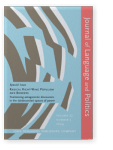Of infiltrators and wild beasts
Nationalism and populism in Benjamin Netanyahu’s narrative of the borders
This paper addresses Benjamin Netanyahu’s border discourse in the context of radical right-wing populism. It
discusses how, in the speeches and statements appearing in his official government website, Netanyahu construes groups located
spatially outside Israel’s borders, mainly terrorists and migrants (the “wild beasts” and the “infiltrators”), as existential
threats to Israel. The aim is to prove that, in legitimizing the militarization of borders through “security fences”, so that the
“other” can be excluded from the nation, Netanyahu uses the same power geometries and discursive strategies, i.e. Proximization
(
Cap 2013) and dehumanizing metaphors (
Santa
Ana 1999,
Musolff 2015,
Taylor
2021), typically used by right-wing populist parties and leaders. By appealing to both populism and certain
interpretations of Zionism, his ethnonationalist view of borders is based on the normalization of the discourse of delegitimation
and exclusion of those groups considered as a threat to the nation.
Article outline
- 1.Introduction
- 2.Borders and “othering” in the discourse of the nation
- 3.Borders and populism in Israel in the age of Netanyahu
- 4.The dataset
- 5.Netanyahu’s border discourse
- 5.1The necessity for a “security fence”: The “villa”, the “wild beasts” and proximization
- 5.2Creating the threat through metaphors: The “waves of infiltrators”
- 6.Discussion
- 7.Conclusions
- Acknowledgements
- Notes
-
References
